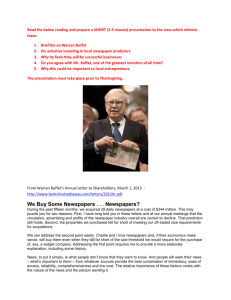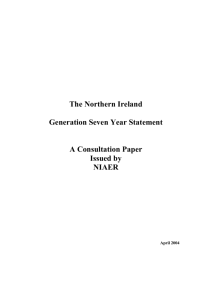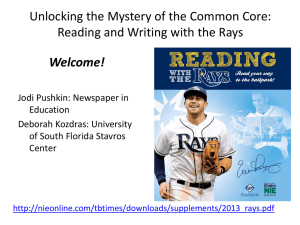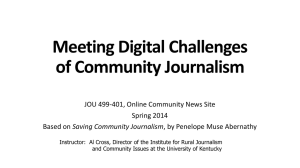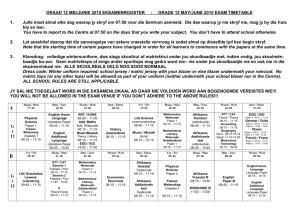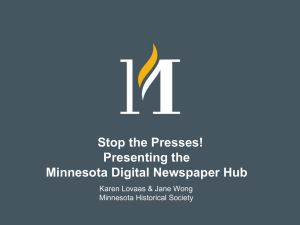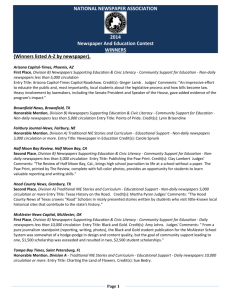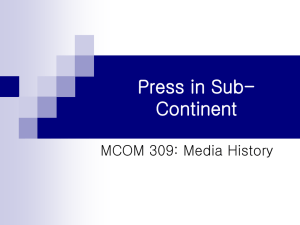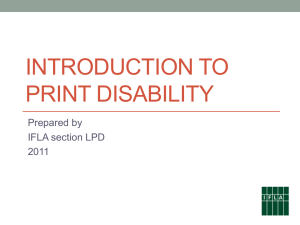Newspaper In Education - Arkansas Reading Association
advertisement
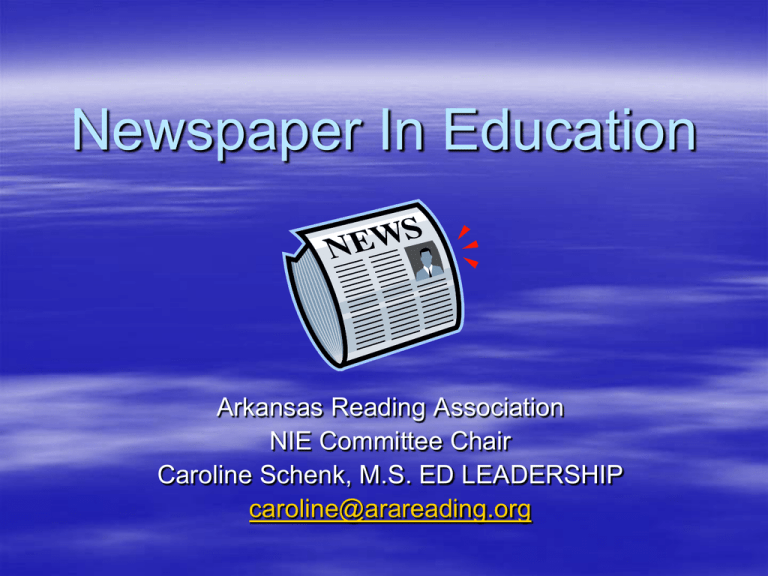
Newspaper In Education Arkansas Reading Association NIE Committee Chair Caroline Schenk, M.S. ED LEADERSHIP caroline@arareading.org Do You Remember Your First Time? Then… Comics? Front page? Sports page? Pictures? Now… Buying a car? Want ads? Travel? Business section? The newspaper is very much a part of a literate life! What is NIE? An international program that began in 1955 to advance the use of newspapers in schools. The main purpose of the program is to improve reading, writing and spelling abilities in students. Why NIE? “There is substantial evidence that using newspapers in schools contributes to students’ reading skills, writing skills, and current event knowledge. The effects are most dramatic among minorities.” Edward F. DeRoche, Dean School of Education, University of San Diego History of NIE… Newspapers in education is a concept dating back to June 8, 1795 when The Portland (Maine) Eastern Herald published the following editorial: Much has been said and written on the utility of newspaper; but one principal advantage which might be derived from these publications has been neglected; we mean that of reading them in schools, and by the children in families. Try it for one session - Do you wish your child to improve in reading solely, give him a newspaper- it furnishes a variety, some parts of which must infallibly touch his fancy. Do you wish to instruct him in geography, nothing will so indelibly fix the relative situation of different places, as the stories and events published in the papers. In time, do you wish to have him acquainted with the manners of country or city, the mode of doing business, public or private; or do you wish him to have a smattering of every kind of science useful and amusing, give him a newspapernewspapers are plenty and cheap- the cheapest book that can be bought, and the more you buy the better for your children, because every part furnishes some new and valuable information. Why NIE? Providing students with newspapers, at a time when they have teacher support, can help prevent illiteracy later. Newspapers open the world to students. Help students become informed and involved citizens. Help students develop critical reading skills by teaching newspaper reading. NIE Mission… Provide educators with an economical, effective and exciting teaching resource for lessons K-12. Convey an understanding of the free press as an essential institution in a free society. Foster students’ personal growth through use of the newspaper to provide information, entertainment, and skills necessary for modern life. NIE Online Gives access to: – Custom classroom lesson plans – Cartoons for the classroom – Front page talking points – Geography in the news – Educational links library You Tube: “Shift Happens” http://www.youtube.com/watch?v=4 Q75KhAeqJg http://www.youtube.com/watch?v=4Q75KhAeqJg So What Does It All Mean??? Kids are bombarded with so much information. It’s our job to teach kids how to process information? How does literacy fit? We are human….we have to process; we have to teach kids how to process; we have to model for kids how WE process. Examples of Accessible Text Newspaper Articles Graphic Organizers Labs Poems Short Nonfiction Selection Fiction Picture Books Short Stories Vignettes Brochures Charts and Graphs Menus Almanacs Magazine Articles Online Newspapers Biographical Information Student Generated Writing Lists Worksheets Photos Postcards Quotes Letters and Journals Song Lyrics Pictures of Artwork Calendars Recipes Maps Accessible Text If students are to understand what they read, then teachers must find text to supplement the textbook – as well as give them time to practice new strategies for understanding the reading during class. Accessible text is timely, well written, and short. It can be read in one class period. It is pleasant to the eye and interesting to read. Accessible text helps students make a connection between school subjects and the real world because it helps them experience reading that is done in the real world. If we are constantly giving students text that is too hard for them to read, they may get through it, but will they really understand it? Many struggling readers feel defeated before they even begin. Accessible Text Pieces Can… Build Background Knowledge: so that readers can better connect what they know to new information. Create Curiosity: so that readers wonder about the topic and are propelled to learn more about it. Show Connections to the Real World: so that readers understand how required reading is important outside of school. Serve as a Piece of Text for Modeling: so that readers can see options on “how” to think about their reading when it gets difficult. Catch of the Day Elicits Oohs and Jaws! The 13-inch pacu that Travis Smith caught Tuesday proved to be a reel struggle to pull in. (Courtesy of Travis Smith ) Eighteen-year-old Travis Smith wasn't surprised to feel a bite on his line when he was fishing in Lakewood this week, but he was surprised by the set of chompers on the fish he pulled from the lake. "At first I thought it was a piranha," Smith said. "But then I thought, 'That's stupid, it's Colorado. It's not a piranha.' " After researching the fish on the Internet and e-mailing photos to the Colorado Division of Wildlife, Smith and his father, Steven, identified the toothy fish as a pacu, a relative of South America's piranha. "It's quite some fish," Steven Smith said. His son was fishing Tuesday at Smith Reservoir, east of South Kipling Parkway… Annotating Text Making Thinking Visible Recording thinking so that it can be remembered and reused. Recording thinking while reading helps a reader remember what he has read. It also provides an opportunity for the reader to wrestle with meaning. Knowing what to write when annotating gives the reader a purpose and also helps the reader determine what is important. Annotating makes the reader’s thinking visible so the teacher can see if meaning is being constructed. (Show your work) Options or Purposes for Annotation: Record questions. (I wonder….?) Record connections. (This reminds me of ….) Record confusions. (I don’t understand….) Record opinions. Record thinking that is new to you. Record the Who. Define who the “biggies” are in the selection and why they are important. Consider their political affiliation, special interests, and with whom they align. Record the What. Describe what is significant about the event and what conditions made the event possible. Record the When. Pinpoint when the event occurred and consider when the issue(s) concerning the event will resurface. Record the Where. Where in the world is this happening? Is the geography significant and have other significant events happened here before? NIE programs exist throughout the state. Check with your local newspapers to see if they have an NIE program. If so, request to be part of it and receive newspapers as part of the partnership. Newspapers online to use as accessible text. Great way to “hook” students as you kick off a new unit of study. Newspaper in Education Week 2010 March 1-5 Critical Thinking Through Core Curriculum: Using Print and Digital Newspapers You can find the link to this material at http://www.naafoundation.org/Curriculum/NI E/NIE-Week.aspx. Everything can be downloaded free of charge. Everyone Can Use A Newspaper RESOURCES 1. National Newspaper In Education www.nieonline.com 2. Arkansas Newspaper in Education www.arkansaspress.org/about-nie 3. Arkansas Press Association www.arkansaspress.org 4. Arkansas Democrat Gazette www.ardemgaz.com/nie
